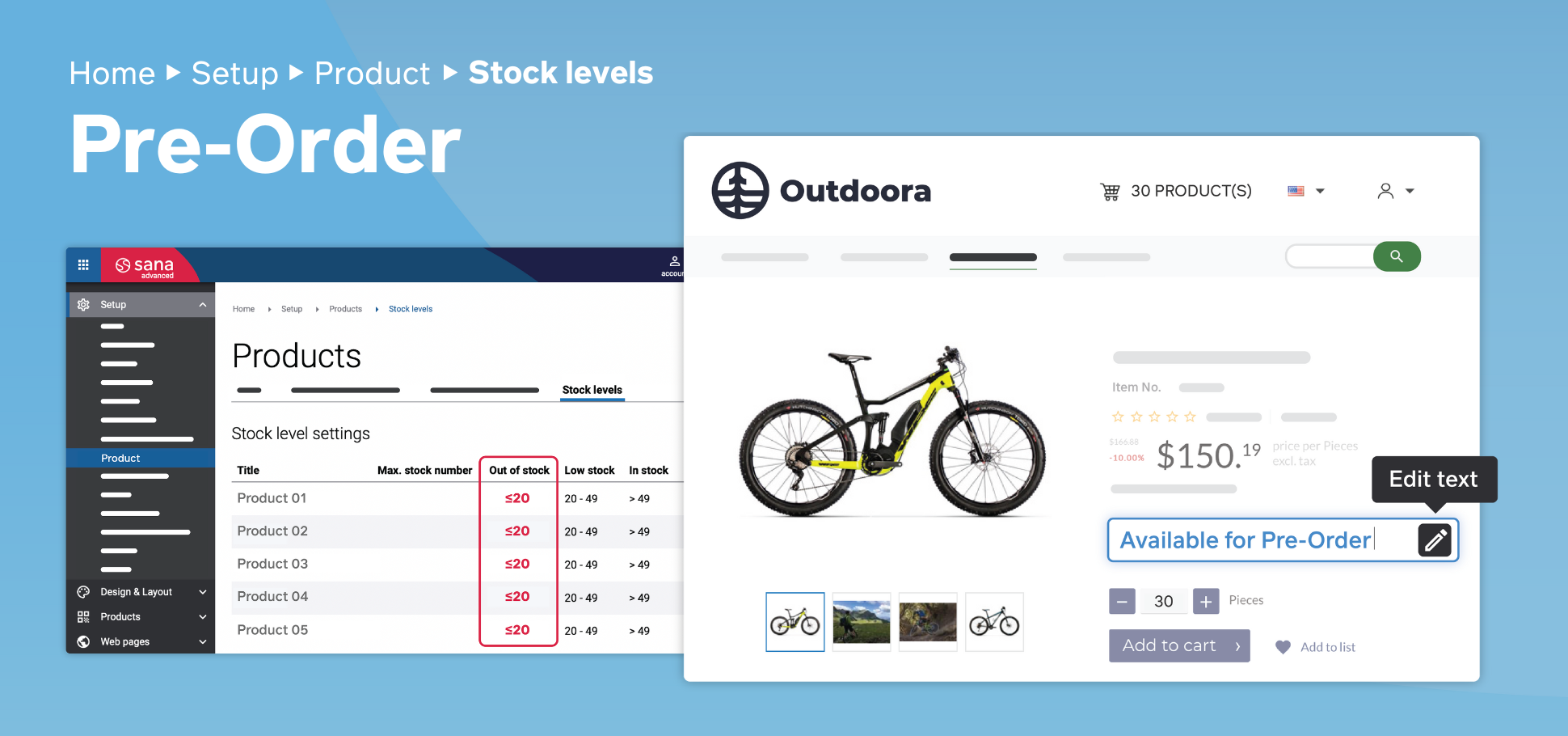

In today’s competitive market, supply chain strategies can make all the difference between stagnation and business growth. One of these strategies is the implementation of pre-orders and backorders.
Pre-order and backorder features not only improve inventory management, but they also help manufacturers, distributors, and wholesalers meet customer demands more efficiently.
What is the difference between a pre-order and a backorder?
Backorder definition
Backordering allows customers to buy a product on your web store even when the product is displayed as out-of-stock on your web store.
Pre-order definition
Pre-ordering allows customers to guarantee their order before the stock has become available for purchase on the web store. With Sana Commerce Cloud’s pre-order feature, customers can pre-order and back-order on the front end of the web store. The only difference is whether or not the stock has been available on the web store in the past.
Let’s dive into the benefits of these strategies for manufacturers, distributors, and wholesalers.
Benefits for manufacturers
Manufacturers can benefit from pre-order and backorder capabilities from both a production and ordering standpoint. Some advantages of utilizing these features include:
- Improve forecasting production
Pre-orders allow manufacturers to gauge customer interest and demand before the product release, enabling them to plan their production accordingly.
- Better cash flow management
With pre-ordering, manufacturers can free up some cash flow by not placing orders for slow-moving items. With this, you can reevaluate how to best utilize resources on popular items rather than reordering items that don’t sell.
The early revenue from pre-orders helps manufacturers in managing cash flows more effectively, reducing the financial burden and risk associated with producing new products
- Better demand analysis
Backorders enable manufacturers to monitor the popularity of certain products over others, providing valuable insights into consumer demand and preferences.
Benefits for distributors
Distributors can utilize pre-order and backorder capabilities to strategically plan how to move and manage inventory. Some advantages of utilizing these features include:
- Reduce inventory costs
Inventory management can be tricky when you don’t have an exact indication of demand. Pre-ordering helps to avoid overstocking the warehouse and tying up capital in inventory. This can give the purchasing teams a safety net when testing out the demand for newly stocked products.
Using this tactic with slow-moving stock can prevent businesses from buying stock with low demand which just results in profit loss. With pre-orders, distributors can keep a lower inventory, saving on storage costs and mitigating the risks of overstocking or understocking.
- Improve relationships with suppliers
This situation happens time and time again: two different salesmen promise the same stock to two different customers. By utilizing the pre-order feature, stock is secured for customers, and promises are kept. This eliminates human error.
Being able to provide suppliers with precise order forecasts enhances supplier relationships and enables better coordination.
- Enhance customer loyalty
Backorders can maintain customer loyalty, as customers appreciate the ability to order even when products are out of stock.
This strategy keeps them from looking for alternatives.
Benefits for wholesalers
- Optimize stock levels
The use of pre-orders can help wholesalers optimize stock levels by allowing them to order just enough to meet customer demand.
- Improve negotiations with vendors
Back-orders provide wholesalers with a better position to negotiate with vendors as they have a clearer understanding of customer demand and preferences.
- Enhance customer satisfaction
Both pre-orders and backorders allow wholesalers to provide continuous service to their customers, enhancing customer satisfaction and retention. Buyers experience frustration and disappointment when they find a product that they need is out-of-stock or not yet available.
In most cases, this can cause the customer to go straight to a competitor. By giving the customers the opportunity to pre-order, you can maintain their loyalty.

A B2B e-commerce platform unlike any other.
When should you use pre-ordering or backordering?
Depending on the context, leveraging pre-ordering or backordering functionalities can be a functional and effective feature on B2B web stores. It’s, for this reason, Sana Commerce Cloud bundles the two, allowing you the flexibility to opt for the right feature based on your use case.
These features can be used if customers want to guarantee order placements on popular products (even though they are out-of-stock). They can also be utilized for web store managers who want to show customers when out-of-stock products will be available. It’s also a useful feature to leverage around product launches, and your purchasing teams are unsure how many units to order.
When to use pre-order
Pre-ordering ensures that the units ordered will be sold and creates hype around the product. This can also give an idea of how many units to order in the future. Providing customers with the opportunity to pre-order an item and being open about communication around this can also build trust and further provide a competitive edge to your web store.
When to use backorder
Backordering can be used when a business doesn’t want to place an order for a specific SKU for fear of having it lay around gathering dust in the warehouse. Another example: if your web store stocks 10 units while your customer is in need of 20 units, they can backorder the other 10 units. This avoids interrupting a purchase and provides your customer the option to redeem potential rewards around loyalty.
How does Sana Commerce Cloud’s pre-order and backorder feature work?
With Sana Commerce Cloud (SCC), buyers can now place orders for items when they are out-of-stock or aren’t released yet. Thanks to SCC’s native ERP-integration feature, once the item is back in stock, it is automatically assigned to the customer that has placed a back or pre-order. For the web store, this means that popular items are identified. In these cases, stock levels can be adjusted accordingly for when the business is ordering from suppliers.
Pre-order is an out-of-the-box content element that can be found within the Sana Admin. Once enabled, it will be shown on the front end of the Sana web store when a customer is logged in.
In conclusion, pre-orders and backorders offer a multitude of benefits for manufacturers, distributors, and wholesalers alike. They improve inventory and cash flow management, enhance customer loyalty, and provide valuable insights into customer demand and preferences. Sana Commerce Cloud’s out-of-the-box pre-order functionality enables buyers to do so without leveraging the information within the ERP system.

Interested in an e-commerce platform built for the B2B use case?
Learn more about Sana Commerce Cloud in a 15-min demo (no download or contact information required).



